9 top SEO recommendations to increase website traffic organically
Are you looking to increase website traffic? Here are 9 top SEO recommendations.
1. SEO recommendation #1 – Statistics
Numbers tell stories. We look for numbers because they help us light a pathway or show us where we should focus our scaling efforts.
Steven Macdonald is an SEO expert with proven stellar track records. He is also a three-time nominee for “Best SEO Campaign”, twice for “Best SEO Team” and once for “Best Content Marketing Campaign” at the Global/ US/ EU Search Awards.
Steven shares great SEO recommendations on his LinkedIn account which I strongly encourage you to follow.
In one of his latest posts, Steven talks about a strategy that works in every industry and is a “goldmine for backlinks”: writing statistics-focused content.
Why? Because writers crave data.
Here is Steven’s process for writing statistics content:
1. Find a topic that relates to your product category
2. Curate *current* stats on that topic into one piece
3. Create a story. Make it engaging (don’t just list a bunch of stats)
4. When quoting stats, always link to the original source
You could publish a stats piece right now and earn links, but the real value lies when you combine stats AND original research
So, step 5: Include original research
Do you want to increase your reach even more?
Here’s an extra tip from Steven: find the missing statistics in your industry.
Writing statistics content is a great strategy and I’ve seen many companies earn hundreds of backlinks and a ton of website traffic, I imagine, with blogs that curated numbers.
What I would add to Steven’s recommendation is to do a quick search on the content that already ranks on Google and pay attention to the numbers in the title.
If there are titles like 10 ways to grow your engagement rate on Facebook posts, then what you want to do is up the ante and go bigger with a title like 25 ways to grow your engagement on Facebook posts.
You need to stand out among the content that’s already ranking in searches.
Here’s an example: 26 user experience UX design stats for digital success
2. SEO recommendation #2 – Original research
In another post, Steven recommends original research as an effective SEO content strategy to increase website traffic.
In the last 12 months, he has used original research to earn backlinks from HubSpot, Magento, and The Telegraph.
These sites are big and their content ranks high in Google searches so earning a backlink from any of them has a huge impact on organic search performance.
The first company I’ve seen applying this strategy and winning big is Buzzsumo with their 2017 article on Facebook video engagement which they wrote after analyzing 100 million Facebook videos published in the previous year. It’s original research content which earned them thousands of backlinks.
The internet is full of fluff content, with the same ideas coming up again and again. It stands to reason that people are looking for original research content which bring s a fresh perspective or the latest insights on a particular topic.
But how do you do original research if you’re not a research company?
Here are Steven’s tips:
1. Use your own data and publish the findings based on how companies in your category use your software (i.e. The average ROI from email marketing based on 1 million campaigns is $X);
2. Send out a survey to your customers, ask questions about industry trends and then publish the answers on your website (55% of businesses plan to increase spend in CX in 2021);
3. Analyze sites in your industry, record best practices/mistakes and then publish that as research;
4. Run a targeted poll on social, collect the results and publish them in your content (i.e. 32% of B2B marketers struggle with demand generation);
5. Partner with a big brand in your space and together, create a unique report on usage, shared-data or engagement (i.e. Based on 10 million data-points, the average sales cycle for enterprise SaaS is X, finds new Brand Y & Brand Z study).
You may think you don’t have the necessary resources. Take a step back and look at your company from a vantage point.
Here’s what I’m talking about: email subscribers, leads, customers, Facebook group members, LinkedIn connections, Instagram followers, social media contest participants, employees etc.
3. SEO recommendation #3 – Roundups
We all want to rank high on the first page in Google search results and focus our efforts to achieve this objective.
But you shouldn’t overlook traffic from social media.
Sharing links to your latest blog on your personal account, company page, group or story is good practice. Every marketer knows that the work doesn’t stop when you hit Publish.
Social media platforms don’t support posts that encourage the user to leave their sites because they’re losing the opportunity to show users ads, therefore, bring in revenue.
But with smart copy, you can get your audience to click on the link and read your piece. In fact, for many companies that rely on fresh content, social media is their second traffic referral.
What you can do to boost your website traffic from social media is to write roundup content.
Round up content is where you put together quotes, insights or other pieces of information from a number of industry experts. Like this article here: 20+ valuable marketing insights from experts.
There are a number of ways you can get the information you need. You can invite the experts to answer your questions or you can browse their content and extract what you need.
After you’ve finished the article, share the link to your content on social media and tag the experts you are quoting in your material.
This will get their attention and they will hopefully share your content with their community. It will help raise awareness of your content, earn clicks to your roundup article and increase traffic.
It’s also a great way to reach an audience that you might not have otherwise.
4. SEO recommendation #4 – Use unique images in your content
Here’s a third recommendation from Steven, one he calls “an often-overlooked marketing tactic”: include unique images in your content.
Why? Because people look for images on Google.
Do you want to know more about a specific business framework?
Instead of reading a 1000-word blog, you could search for PESTEL analysis, for example, on Google images and find illustrations that communicate the essence of this business framework in a beautifully designed image. If you need further information, click on the image and voila! you’re a new website visitor.
Should all your blogs include unique images?
Yes. But if you don’t have the necessary resources, you should do a selection.
Here’s the process Steven uses:
1. Find your most linked-to blog post (Ahrefs > Pages > Best by links)
2. Hire a designer and replace all assets with new, unique images
*The next 2 steps are crucial*
3. Give the image an SEO-friendly file name (i.e. linkedin-post.jpg).
Upload it
4. Use the same file name as the image alt text (i.e. LinkedIn Post)
5. Click SAVE. Repeat this process for at least 10 more posts
As Steven puts it, “Good design doesn’t compete with copy. It makes it better.”
5. SEO recommendation #5 – People also ask
Google search bar is not the only information source where marketers discover what people are looking for, what they want to read and what problems they are looking to solve.
What marketers should take into account when writing a piece of content is the questions in the People also ask box.
People also ask is a Google feature that answers questions related to the user’s search query. In this feature, Google shows the answer to one question with a clickable link to the source.
It’s a good SEO strategy to write content that answers people’s questions. So all you need to do if you want to write content that people want to read is discover what questions people are asking and include your answers in your content.
People also ask is a great source for new content generation.
6. SEO recommendation #6 – Google’s Page Experience Update
In 2020, Google announced the rollout of a new update that will influence websites ranking in search results. The update focuses on page experience signals.
Here’s what Google says in the announcement:
These signals measure how users perceive the experience of interacting with a web page and contribute to our ongoing work to ensure people get the most helpful and enjoyable experiences from the web.
The new page experience signals combine Core Web Vitals with our existing search signals including mobile-friendliness, safe-browsing, HTTPS-security, and intrusive interstitial guidelines.
The update will roll out in June 2021.
The page experience update is important because Google plans “to test a visual indicator that highlights pages in search results that have great page experience.”
What does this mean for companies looking to drive website traffic from Google search results?
The pages highlighted by Google as having a good page experience will rank before the pages with no such indicator.
I’ll let Greg Gifford, experienced local SEO consultant tell, you more about Google’s upcoming Page Experience update:
7. SEO recommendation #7 – Optimize content for click-based signals metrics
One of the subjects that SEOs have been debating over for a long time is whether or not Google uses click-through rate in its ranking algorithms.
SEO expert Cyrus Shepard argues in his piece on the Moz blog that this debate misses the point.
We shouldn’t ask ourselves if Google uses clicks for ranking, we should assume Google uses clicks for rankings.
In his article, Cyrus provides an in-depth analysis of a patent Google published recently called “Modifying search result ranking based on implicit user feedback.”
According to Cyrus, Google uses 3 types of clicks to calculate engagement metrics for SEO.
Here they are as described by Cyrus:
More Clicks (“High CTR“): earns you more traffic no matter your rank, and initial clicks form the basis of all subsequent click metrics.
Improved Engagement (“Long Clicks“): almost always a positive sign from your users, and often an indicator of quality as well as being correlated with future visits.
User Satisfaction (“Last Click“): the holy grail of SEO, and ultimately the experience Google strives to deliver in its search results.
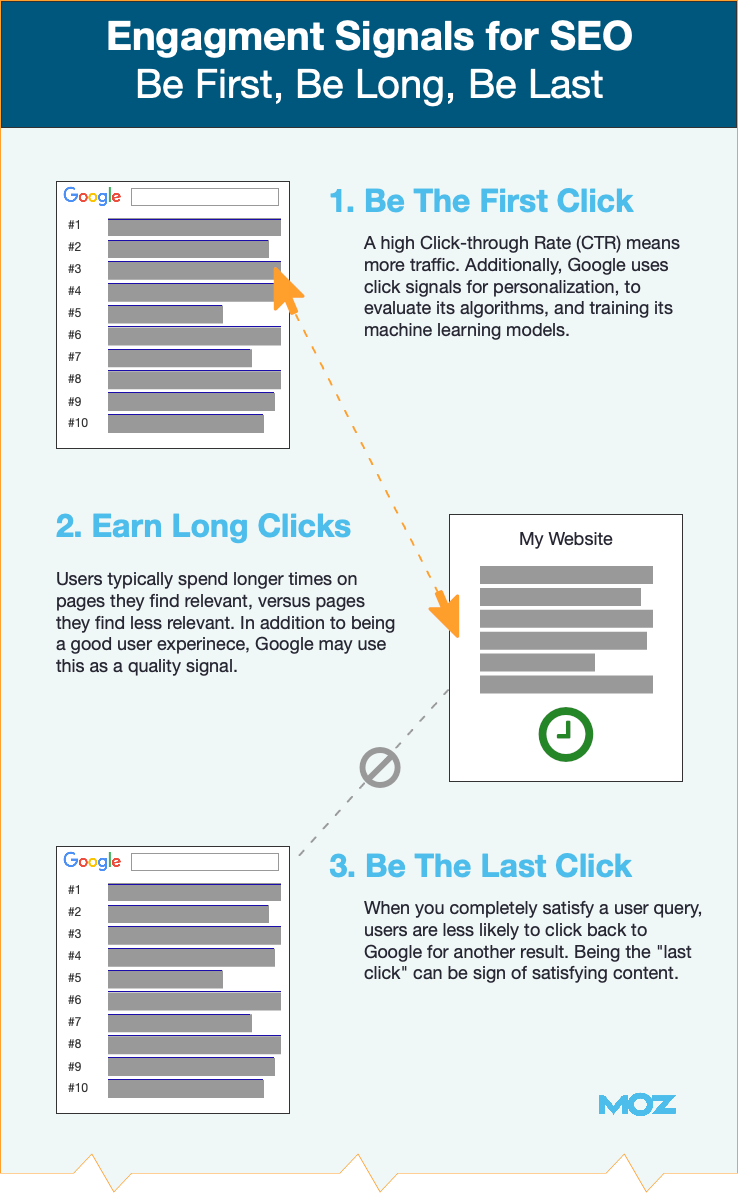
8. SEO recommendation #8 – Updating high-performing content
John Bonini, Director of Marketing at Databox and a marketer with 10 years of experience, says this in a LinkedIn post:
“If you’ve been blogging for more than 12 months, your biggest short-term growth opportunity is *not* publishing new content.
The biggest opportunity?
Updating the “old” stuff.”
What John recommends is not updating any old posts. He has perfected the selection process for updating content and found 3 types of content that should be updated:
The Biggest Losers: Content that’s decayed at a high traffic volume.
The Almost Famous: Content that’s currently ranking on page 2.
The Nobodies: Content that’s targeting high-intent, high-volume keywords that are not ranking at all.
If you want to learn more about John’s content updating process, connect with him on LinkedIn.
9. SEO recommendation #9 – Content series
People learn more easily when information is organized in an efficient way: lists, categories, how-tos etc.
Writing content in easily digested formats is also a good strategy for the content writer.

I found that writing content on a specific topic in the form of a series provides many benefits for our audience and our brand.
The content series helps the brand stay top of mind with its audience and the audience learns what to expect from this type of content.
If the content is relevant and interesting, you have a winner because it helps the marketer achieve one of the most important goals in marketing: to influence behaviour.
We’ve had success with the Failure Stories series which features some of the biggest failures in business while providing the reader with an opportunity to learn from their mistakes (Nokia, Toys R Us, Forever21, Thomas Cook, Kodak).
Another successful series is Growing Industries where we highlight the industries that are set to register significant growth in the near future. If you are looking to invest funds or are unsure which market to enter, this series is a good starting point.
What SEO recommendations do you follow?
Share in comments.
Join the Conversation
We’d love to hear what you have to say.
Get in touch with us on our LinkedIn Page, Facebook Page, Twitter or TikTok.
15 LinkedIn Statistics Every Marketer Needs To Know
If you haven’t yet included LinkedIn in your marketing mix, then now is the time.
Here are 15 updated statistics on LinkedIn that you need to know:
1. 610 million members in 200 countries and territories;
2. LinkedIn audience analysis: 46 million B2B decision makers, 10 million C-level executives, 6 million IT decision makers, 17 million opinion leaders, 40 million mass affluent;

source: LinkedIn
3. 30% growth year-over-year in the number of sessions on LinkedIn;
4. 2 professionals join LinkedIn every second;
5. 45% of LinkedIn users are in upper management (CEOs, directors, vice-presidents etc);
6. 9 billion content impressions;
7. 94% of B2B marketers use LinkedIn to distribute content;
8. LinkedIn is the #1 social network for lead generation;
9. 57% of users access LinkedIn on mobile;
10. 2 million posts, articles and videos are published on LinkedIn every day;
11. 80% of leads come from LinkedIn;
12. Elevate, LinkedIn’s employee advocacy program can drive a 24x increase in social media engagement;
13. LinkedIn is the most successful platform for content marketing purposes;
14. There are 30 million company pages;
15. LinkedIn is the most trusted social platform.
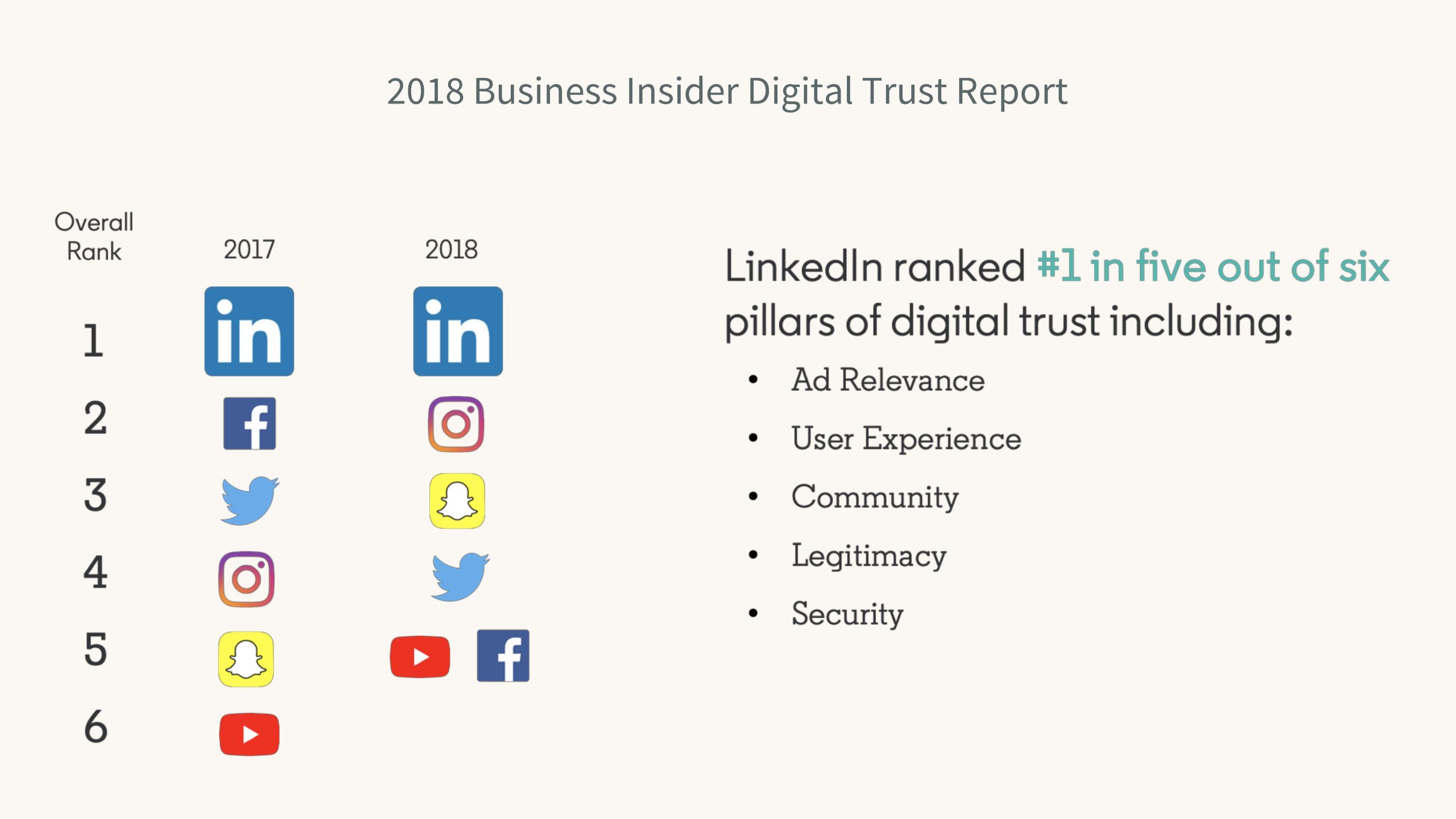
source: LinkedIn
Conclusion
LinkedIn is the perfect social media platform for B2B companies, salespersons, professionals looking to grow their personal brand, thought leaders and world-changers.
If you are planning to include LinkedIn in your marketing mix, here is another resource for your inspiration: how to use LinkedIn’s native video tool to raise brand awareness and attract leads.
Join the Conversation
We’d love to hear what you have to say.
Get in touch with us on Facebook Group and Twitter.
What Voice Search And AI Mean For Your Business
By 2020, around half of all searches will be conducted through voice search.
At least, that’s what the team at SEO Tribunal discovered when it conducted extensive research into the area.
Voice search is not a novel concept. If you have a smartphone, tablet, or even a laptop, you might already have used it yourself.
There’s no question that it makes searching for things online a lot simpler. After all, why type out a query when you can just ask your device to look for the answer?
If you’re not that clued up when it comes to voice search, the infographic below will tell you all that you need to know.
In this post, however, we’re more interested in how voice search and AI will affect businesses going forward.
Are you ready to learn more?
Advances In AI Have Made Voice Search Viable
The earliest versions of personal assistants were comparatively stupid by today’s standards. You had to get the exact keyword and spelling right to get close to getting the right answer. Even then the results were not very accurate.
Today however, AI is far more advanced, making voice searches a lot more accurate. In addition, virtual assistants like Siri, Cortana, Duplex etc. can collect results on their own and give you a quick summary of what they found.
The increase in the capabilities of these assistants has led to the creation of smart devices, such as smart speakers. These devices make full use of voice recognition software and can become a hub in the home.
All you have to do is to say the magic phrase, like Hello Google and your speaker will be activated. From there, you can run a voice search or tell your assistant to play music, for example.
What’s Does This Mean for Your Business?
Well, for starters, it means that your site must be optimized for voice search. But don’t let that stress you out too much, it’s not that much of a departure from what you are doing already. What you need to do is to start thinking as someone would if using a voice query.
Queries Are Changing
When we try to type out a query we tend to be a bit more economical with the number of words we use. We aim to use the minimum number of words because that means less typing. This further means that it’s a lot easier to narrow down the number of keywords to target.
With voice search, the opposite is true. We simply phrase the query as we normally would. It means that the number of keywords that might be used increases a lot. Also, the queries will take the form of questions, rather than simple phrases.
How to Prepare for Voice Search
It is actually a lot easier to optimize content for voice search than you might think.
You’ll need to think about the types of questions that people might ask in relation to your business, and then incorporate these into your site.
Setting up a comprehensive FAQ page is a good way to get started. But you can also start to incorporate more question style content on your site. So, for example, you could create a post titled,” What process do we use?” instead of “The Process We Use.”
It’s a subtle distinction, but one that better matches the format of queries to come. It will also work well when it comes to typed queries, so it’s not going to hurt your results now either.
Consistency Is Essential
There is one area where voice search could hurt business though, and that’s when it comes to the aggregated content provided.
Let’s say that someone asks Google for information about music shops in the area. Google will create a summary of the information based on numerous sources. What Google cannot do, however, is check that the information is correct. It could be a problem for you if there is info out there that is incorrect.
Say, for example, that your business was listed in a few online directories and then you moved. It isn’t a problem for you, you just update the information on your site. But Google will still pick up that old information and could present it in its findings. This means that the searcher could receive your old address and telephone number. And who do you think they’ll blame because the info is incorrect? That’s right – your business.
To get around this, run regular checks on your business’s information online in all sources and make sure that it is all correct and consistent.
In general, optimizing for voice means approaching things from a slightly different perspective, but it is not a major adjustment by any means.

Join the Conversation
We’d love to hear what you have to say.
Get in touch with us on Facebook and Twitter.
Video Marketing Statistics 2018 – How Brands used Video for Business
Brands use video marketing to help them achieve various marketing and sales goals. Although creating such content may be challenging for marketers, when brands combine creativity and customer insights, it’s a win-win situation.
Here are 8 statistics regarding video consumption and the results reported by brands who used video marketing (source: wyzowl):
- Where both video and text are available on the same page, 72% of people would rather use video to learn about a product or service;
- In a typical day, people watch 1.5 hours of video on average and 15% watch more than 3 hours of video;
- If you create video content that your specific audience enjoys, 83% of consumers would consider sharing it with their friends;
- 85% of people say they expect to see more video from brands in 2018;
- Sales increase – 76%;
- Traffic increase – 76%;
- Increased dwell time on website – 80%;
- 81% of people have been convinced to buy a product or service by watching a brand’s video.
Vidyard, a video platform that helps businesses transform communications and drive more revenue through the strategic use of online video, has released its 2018 Benchmark Report – Video in Business.
Their insights are based on first-party data collected from the Vidyard video platform from more than 600 businesses and over 250.000 videos in a 12 month period.
Here are the findings of Video in Business report:
-
Consumption of business-related video content
Consumption of business-related video content is predominantly taking place on desktop browsers – 89% desktop, 11% mobile.
58% of video views are performed on Chrome.
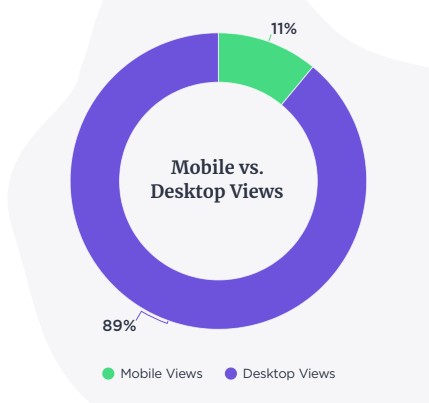
2018 Video in Business Benchmark Report
-
The highest traffic time is middle of the week
The highest traffic is on Tuesdays, Wednesdays and Thursdays with 18%.
The highest viewership on Tuesdays, Wednesdays and Thursdays is between 10 am – 13 pm, while on Mondays and Fridays the viewership shifts to 12 pm – 15 pm.
The lowest viewership for business videos is on Saturdays and Sundays.
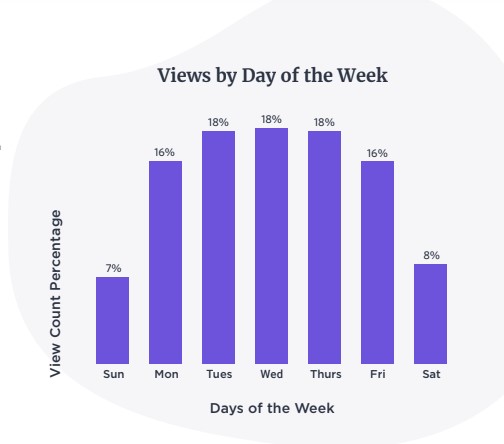
2018 Video in Business Benchmark Report
-
The industry with the highest number of videos published in total
The industry with the highest number of videos published is High Tech with 637 videos, followed by Professional Services with 274 videos and Media, Entertaining & Publishing with 247 videos.
A company in High Tech publishes on a monthly average a number of 53 videos.
The months with the highest number of videos are August, October and November – 11%.
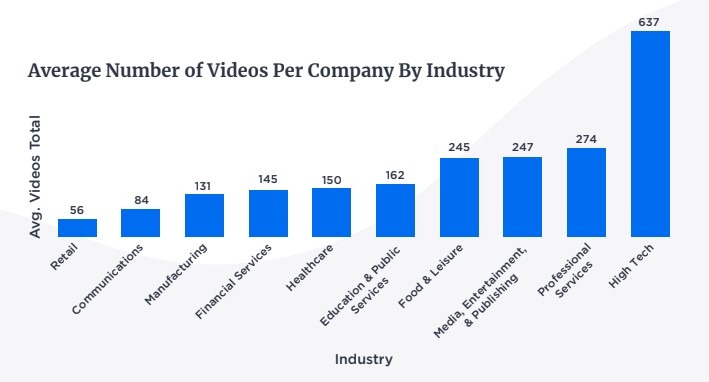
2018 Video in Business Benchmark Report
-
Video production resources
47% of large companies use a combination of internal and external resources while 54% of small businesses and 50% of medium businesses use internal resources to produce their videos.
-
Top 3 Video content by type
63% are product related videos, 59% demos, 54% explainer videos.
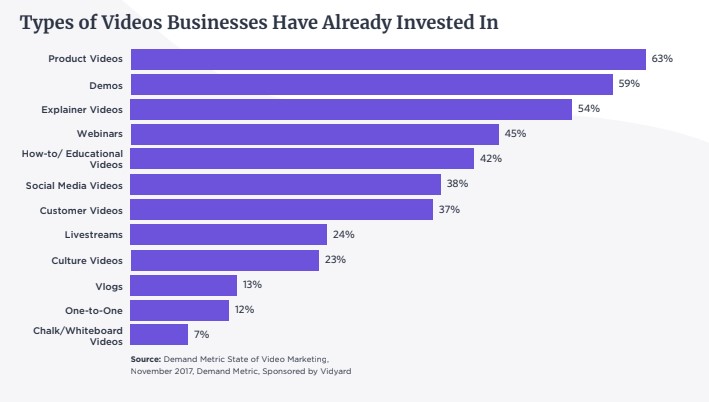
2018 Video in Business Benchmark Report
-
Top 3 video distribution channels
86% of companies host their videos on their website, 77% share them on social media and 60% place them on landing pages.
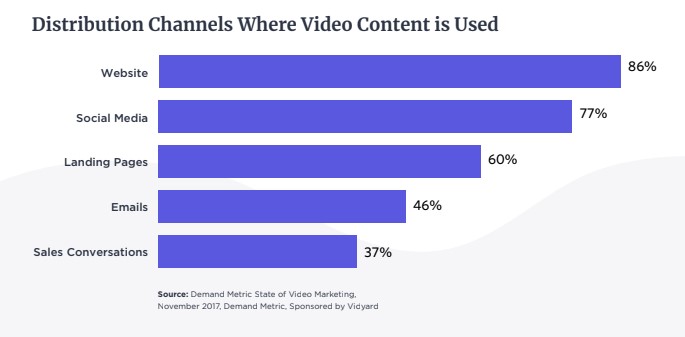
2018 Video in Business Benchmark Report
-
Video length
75% of videos are less than 2 minutes, 54% up to 60 sec.
51% of companies use basic video performance analytics, 23% use intermediate, 13% use advanced and the rest of 13% use no analytics at all which means the companies using advanced analytics are twice as likely to report the return on their video investments.
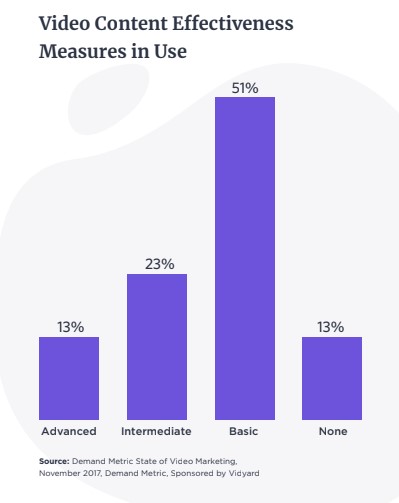
2018 Video in Business Benchmark Report
Conclusions:
- Videos published on average: 377;
- New videos published every month: 33;
- The video libraries of businesses will double within 12 months;
- Most new videos are published by businesses in High Tech and Professional Services;
- Businesses have seen a growing demand for videos throughout their customer life-cycle;
- Companies use videos for their mid and bottom marketing funnels;
- Businesses using videos on landing pages jumped from 49% to 60%, businesses using video in email jumped from 36% to 46%, video in sales conversations increased from 25% to 37%;
- Companies are either producing very short videos (up to 2 minutes) or long-form videos such as webinars;
- The average retention rate by end of a video is 46%;
- 86% of marketers using advanced analytics reported they were satisfied with their video marketing results.
2018 MailChimp Statistics for Successful Email Marketing Campaigns
Email marketing is still the best tool to attract leads, convert them to customers and increase sales.
MailChimp is one of the leading email provider. MailChimp’s researchers are constantly analyzing data to help you make the most of your marketing campaigns.
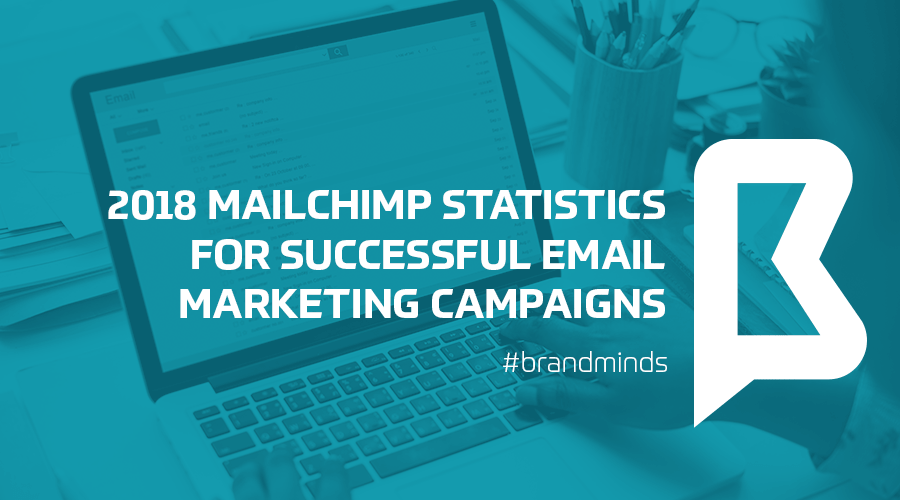
We put together a list of 2018 statistics we found in MailChimp reports.

You can use this knowledge to turn your email marketing campaigns into a successful tool:
1. Smartphone subscriptions and traffic per phone will have respective annual growth rates of 15% and 25% until 2020.
2. Mobile Use has a negative impact on Email Engagement: readers click less on mobile:
- PCs, tablets, and mobile devices accounted for 64%, 9%, and 27% of email addresses;
- PCs, tablets, and mobile devices accounted for 72%, 9%, and 18% of clicks;
- Recipients who use mobile phones had unique and total click rates of 2.7% and 3.9%, worse than all other device categories.
3. Responsive design can improve engagement
Campaigns that use responsive templates have higher click rates in general, but the impact seems to be mixed at the link-depth level.
Only the first 3-5 links typically see a benefit from the use of a responsive template.
4. Segmented campaigns perform better than non-segmented campaign
By narrowing your focus and sending messages to targeted groups within your lists, your recipients will find your campaigns more relevant—and relevant campaigns get better results.
Here are the results of email marketing campaigns using lists segmentation:
Opens: 14.31% higher than non-segmented campaigns;
Unique opens: 10.64% higher than non-segmented campaigns;
Clicks: 100.95% higher than non-segmented campaigns;
Bounces: 4.65% lower than non-segmented campaigns;
Abuse Reports: 3.90% lower than non-segmented campaigns;
Unsubscribes: 9.37% lower than non-segmented campaigns.
There are many types of list segmentation and MailChimp has looked into it.
Segmentation by merge field (“customer_type,” “ZIP code,” or “job_title,” for example):
Opens: 14.06% higher than non-segmented campaigns;
Unique Opens: 9.15% higher than non-segmented campaigns;
Clicks: 54.79% higher than non-segmented campaigns;
Bounces: 0.79% higher than non-segmented campaigns;
Abuse Reports: 3.33% lower than non-segmented campaigns;
Unsubscribes: 7.19% lower than non-segmented campaigns.
Segmentation by Date Added/Signup Date:
Opens: 29.56% higher than non-segmented campaigns;
Unique Opens: 26.86% higher than non-segmented campaigns;
Clicks: 51.64% higher than non-segmented campaigns;
Bounces: 55.18% higher than non-segmented campaigns;
Abuse Reports: 29.55% higher than non-segmented campaigns;
Unsubscribes: 33.76% higher than non-segmented campaigns.
Segmentation by Interest Groups:
Opens: 9.92% higher than non-segmented campaigns;
Unique Opens: 5.54% higher than non-segmented campaigns;
Clicks: 74.53% higher than non-segmented campaigns;
Bounces: 17.61% lower than non-segmented campaigns;
Abuse Reports: 17.78% lower than non-segmented campaigns;
Unsubscribes: 25.65% lower than non-segmented campaigns.
Segmentation by Subscriber Activity:
Opens: 10.44% higher than unsegmented campaigns;
Unique Opens: 12.23% higher than unsegmented campaigns;
Clicks: 15.69% higher than unsegmented campaigns;
Bounces: 9.23% lower than unsegmented campaigns;
Abuse Reports: 10.34% higher than unsegmented campaigns;
Unsubscribes: 5.49% higher than unsegmented campaigns.
5. Subject Line Data: Choose Your Words Wisely
Personalization works
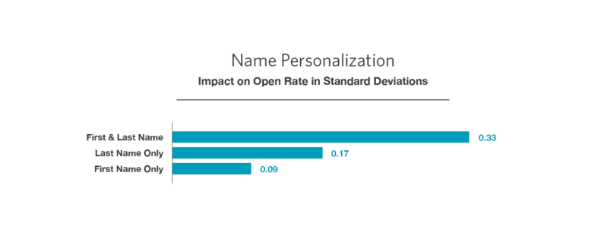
Personalization by industry
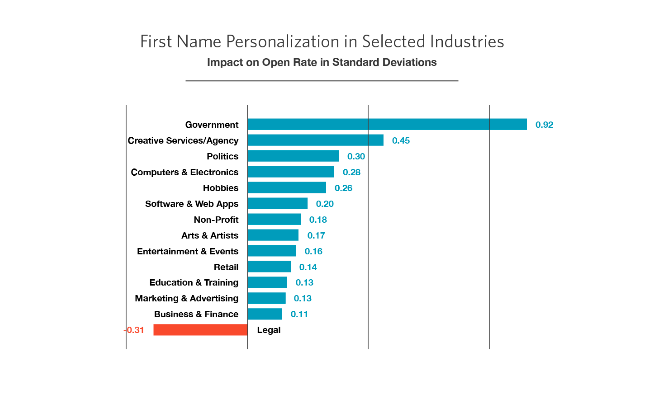
People respond to a sense of urgency or importance
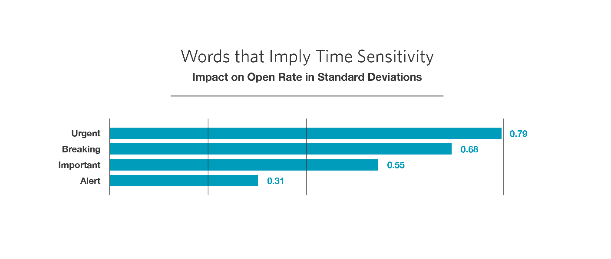
“Free” works but “Freebie” is better
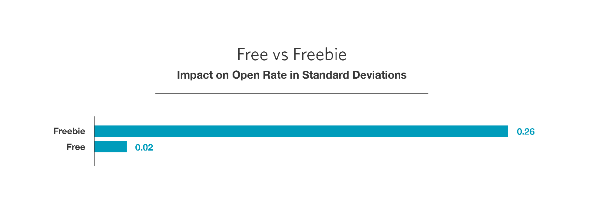
Announcements get opened
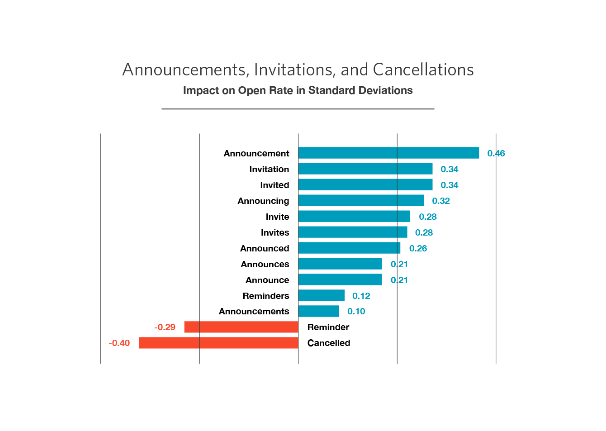
“Helping” instead of “Donate”
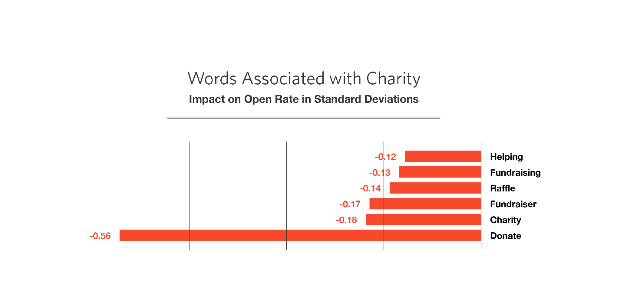
6. The average open rate for all industries is 20.81%
The most opened emails are related to hobbies, with an open rate of 27.35%;
Emails sent by government entities come in second, with a 26.52% open rate;
With a 26.03% open rate, emails about the arts and artists came in third.
7. The average click rate for all industries is 2.43%
Hobbies also have the highest click rate, which is 4.78%;
Media and publishing emails see the second highest click rate, at 4.55%;
Government comes in third, with a 3.65% click rate.
If you are interested in improving your email marketing campaigns, join us at Digitalium, The Hottest Digital Marketing Conference and learn from Kath Pay, Email Marketing Expert.
21 Google Statistics & Info with the occasion of Google turning 20 in 2018
Google turned 20 in 2018.
During these twenty years, Google changed the world: it has become the most-used search engine service on the planet, the verb to google was added to the Oxford English Dictionary and the business environment has begun the ongoing battle for ranking on page one.
The best place to hide a dead body is page two of Google.
Unknown
The giant company has gone far beyond its core service of returning results to individual queries, developing 23 additional services and products (some acquired):
- Work and productivity (Google Docs, Sheets, and Slides);
- Email (Gmail);
- Scheduling and time management (Google Calendar);
- Cloud storage (Google Drive);
- Social networking (Google+);
- Instant messaging and video chat (Google Allo, Duo, Hangouts);
- Language translation (Google Translate);
- Mapping and navigation (Google Maps, Waze, Google Earth, Street View);
- Video sharing (YouTube);
- Note-taking (Google Keep);
- Photo organizing and editing (Google Photos);
- Web browser (Google Chrome);
- Operating system (Chrome OS).
and so on.
We are not really interested in search. We are making an Artificial Intelligence.
Larry Page
Let’s recap some of the most important landmarks in Google history and also discover latest statistics and new features in an attempt to profile the future of Google:
1.In 1998, asked why start another search engine company (AltaVista was the most-used search engine at that time), Larry Page reportedly answered, “We are not really interested in search. We are making an Artificial Intelligence”.
2. Google was funded with money from Andy Bechtolsheim, (co-founder of Sun Microsystems), Jeff Bezos (Amazon), David Cheriton (Stanford University computer science professor,) and Ram Shriram (entrepreneur).
3. In 2002, Google launched its Library Project (Google Books) by scanning library books with the purpose of digitalization. In 2005 Google was taken to court by Authors Guild (representatives of authors, publishers and libraries) arguing copyright infringement by creating digital copies of copyrighted works. By 2008, the parties reached a settlement to make the full library available to the public, for pay, and to institutions. Google agreed to pay $125 million.
4. Google used various tax avoidance strategies, saving $3.1 billion in taxes between 2007 and 2010.
5. Google Brain – Google Brain is a deep learning artificial intelligence research team at Google. Formed in early 2010s, Google Brain combines open-ended machine learning research with system engineering and Google-scale computing resources.
6. Google DeepMind – DeepMind Technologies’ goal is to solve intelligence, which they are trying to achieve by combining the best techniques from machine learning and systems neuroscience to build powerful general-purpose learning algorithms.
Acquired by Google in 2014, the company has created a neural network that learns how to play video games in a fashion similar to that of humans. DeepMind’s AI technology is the engine behind the following programs: AlphaGo and AlphaZero (programs which have beaten both professional players and programs at various games) and Google Duplex, the Google Assistant.
7. In 2017, Google accounted for over 79% of all global desktop search traffic, followed by Bing at 7.27%, Baidu at 6.55% and Yahoo at 5.06%.
8. On June 27 2017, the company received a record fine of €2.42 billion from the European Union for “promoting its own shopping comparison service at the top of search results.”
9. Google’s global revenue in 2017 – $109.7 billion.
10. Advertising revenue of Google in 2017 – $95.4 billion.
11. Google.com is visited most by the users in the United States with a global share of 34.3% as of February 2017.
12. Among the leading search engines, the worldwide market share of Google in January 2017 was 89%.
13. Gmail: Google’s email service had 1 billion active users worldwide in February 2016.
14. Percentage of internet users that Google Display Ads reach: 90%.
15. Number of websites with Google AMP: 31 billion.
16. The number of daily searches on Google – 3.5 billion.
17. 50% of search queries are four words or longer.
18. The average first-page result on Google contains 1,890 words.
19. Google “near me” searches have increased 2x over the past year.
20. The query “___ to avoid” has risen by 150%, and the query “is ___ worth it” has risen by 80%.
21. Latest features and programs launched in 2018:
Google News Initiative (a new program designed to help combat fake news and support journalism),
Google Lens (moving the search from text to visual),
Google Activity Cards (showing you previous pages/sites visited and previous queries),
Google Collections (allows users to save and organize content on their phones).
The information in this article was curated from the following sources: techcrunch.com, statista.com, expandedramblings.com, smartinsights.com, searchenginewatch.com, wordstream.com, wikipedia.com.
Marketing research done right
Either you start a new business, launch a new project / product / service or you just want to stay ahead of your competition, a strong and smart marketing research will give you the necessary advantage over the competition. Moreover, in this ever-changing and moving market, with the technology changing it day by day and with consumers always up-to- date and in control of the situation, research becomes more and more important daily. Therefore, market research is a key component of any good product team management process, sales and marketing strategy, or business growth strategy.
“Marketing research can give a business a picture of what kinds of new products and services may bring a profit. For products and services already available, marketing research can tell companies whether they are meeting their customers’ needs and expectations. By researching the answers to specific questions, small-business owners can learn whether they need to change their package design or tweak their delivery methods–and even whether they should consider offering additional services,” writes entrepreneur.com.
Research deserves its important place in a business activity and should be treated accordingly. We are presenting you some of the steps you must take in order to make sure your research is done right.

source: AdWeek
- Primary research focuses on gathering data from analyzing current sales and the effectiveness of current practices. It also takes competitors’ plans into account, giving you information about your competition. The pieces of information will be received following: interviews (qualitative and quantitative), surveys, questionnaires (online or by mail), focus groups.
2. Secondary research. Analyzing the data that has already been published. and that can help you identify competitors, establish benchmarks and identify target segments. Your segments are the people who fall into your targeted demographic–people who live a certain lifestyle, exhibit particular behavioral patterns or fall into a predetermined age group.
3. Study the Economy: Just like the history is important in knowing and understanding who we are as a culture and what we will be in the future, showing what we can expect, so is knowing and understanding the economy helping your business grow. You can better understand reports about some of the most important big factors affecting the industry you’re in and the customers you hope will spend their money on your products or services.
Being up-to-date with the economics world will help you know how to adjust your business, prevent difficult situations and choose the right time to expand.
4. Read Business and Industry Publications: Whatever your industry, there’s likely a trade group or research firm out there compiling industry statistics and trends that are all insights into your business. Join your industry trade group or follow key industry thought their leaders on social media and media (their TV, print, online appearances). Being part of the industry and its insights will help you find out detailed industry statistics and trends that can help you better understand the past, present and future of companies like yours.
5. Look Elsewhere: Take example from successful local and international businesses. A similar business on the opposite end of the country may give you some great promotional ideas, or an international market could start complaining about rising commodity prices before they affect you directly.
6. Hire a smart internal researcher and a good research agency. Your researcher will be able to present you monthly reports regarding the market and your consumers, while the agency will be a key element when making an important move on the market. They will for sure make the difference.
More ideas and steps you can find here.

